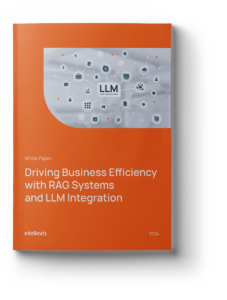AI promises usefulness in marketing, where teams often face challenges related to task automation, data analytics, content creation, and others. Since the potential of AI here is immense, it’s totally worth delving into its usage and adoption.
In this post, you’ll discover a suite of top applications of Generative AI in marketing, explore three best practices for generative AI marketing strategies for businesses, and review challenges you may face during an AI system implementation. Besides, you’ll get to know some of the most notable Generative AI in marketing trends, which may soon become common applications.
Real-world examples of generative AI in marketing
For starters, let’s have a quick look at stats and numbers revealing the impact of Generative AI.
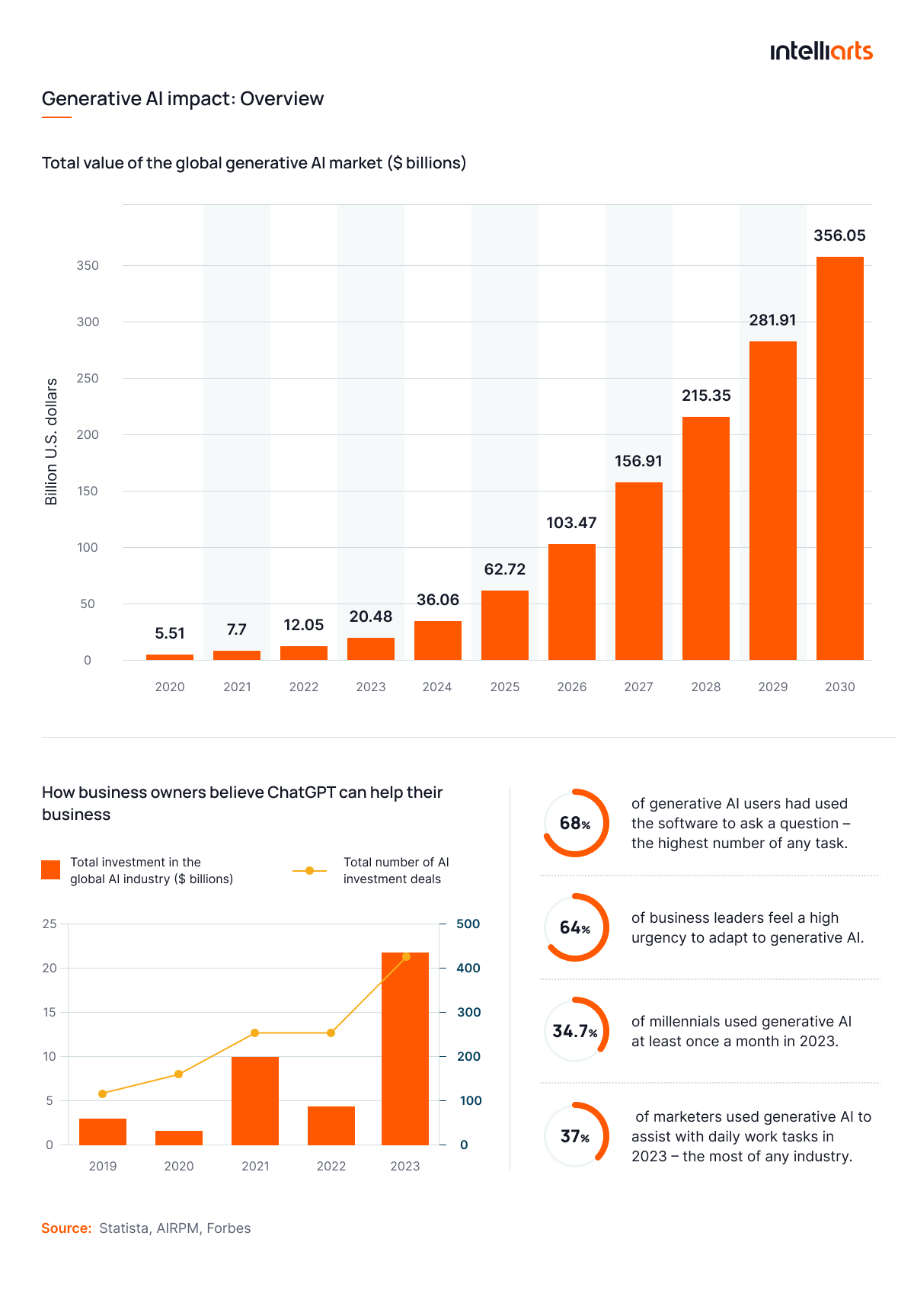
Curious about what are the key applications of generative AI in marketing? Now, with an understanding of how huge and valuable the role of Generative AI is, let’s explore how to use generative AI in marketing through practical applications in modern-day strategies.
#1 Personalized marketing campaigns
Generative AI enables the creation of hyper-targeted campaigns due to its vast capabilities to analyze consumer behavior and preferences based on big data. It helps to deliver personalized content at scale, leading to improved customer engagement and higher conversion rates. When considering tools for implementing such strategies, understanding the differences between Claude vs. ChatGPT can be beneficial.
How Generative AI assists:
- Automated customer segmentation based on demographics, behaviors, and purchasing history.
- Predictive analytics for content based on customer preferences and predicted behaviors.
- Automated personalized email and ad generation.
- Real-time interaction personalization, i.e., adaptation of content dynamically based on user interactions and engagement patterns.
- Behavioral trend analysis.
Real-life example:
Starbucks uses its Deep Brew AI platform that enables it to analyze customer data and preferences with the prospect of personalizing customer interactions based on purchase history.
#2 Dynamic advertisement creation and optimization
Generative AI enhances advertising effectiveness by automating the creation of dynamic and contextually relevant ads. Leveraging real-time data and audience insights, generative AI transforms marketing campaigns, ensuring higher engagement and improved ROI. It is especially valuable for brand awareness advertising, helping brands reach wider audiences with personalized and memorable messages.
How Generative AI assists:
- Automated A/B testing for quick evaluation of ad variants.
- Real-time performance monitoring with content and targeting adjustments.
- Context-aware content adaptation, including location- or device-specific modifications.
- Automated multilingual ad generation to target diverse global audiences.
- Dynamic ad template creation tailored to specific platforms and audience segments.
Real-life example:
Coca-Cola announced a collaboration with OpenAI and has started using generative tools to create dynamic branding campaigns. They leverage a vast suite of Generative AI capabilities, from an advanced image generation solution and AI search chatbots to creating out-of-home advertising experiences.
#3 Customer journey mapping and predictive analytics
Generative AI empowers businesses to visualize and predict customer journeys by analyzing vast datasets. It enables proactive decision-making, ensuring tailored experiences across touchpoints while boosting customer satisfaction and retention rates.
How Generative AI assists:
- Automated customer journey mapping with actionable insights.
- Prediction of drop-off points and customer behaviors.
- Identification of high-value touchpoints for personalized interactions.
- Real-time recommendations for upselling and cross-selling opportunities.
- Sentiment analysis to refine customer engagement strategies.
Real-life example:
Amazon offers SageMaker, which is an AWS ML and AI platform that provides unified access to data and a vast range of data analytics capabilities. Among many usages of this instrument, it offers merchants using the Amazon platform data-driven options to anticipate customer needs, with Amazon offering timely product recommendations based on browsing and purchase patterns.
#4 Creative design and visual content generation
Generative AI revolutionizes creative processes by producing high-quality visual assets at scale. It supports marketing efforts with customized designs, saving time and reducing costs while maintaining brand consistency. Tools like this image generation tool offer a quick and scalable way to create visuals for various platforms and audiences.
How Generative AI assists:
- Automated generation of logos, banners, and ad visuals.
- Creation of reusable banner templates that streamline campaign design and ensure brand consistency across platforms.
- Creation of hyper-personalized content for different demographics.
- Dynamic video editing and animation based on campaign goals.
- Style transfer for content aligned with specific aesthetics or brand guidelines. A well-defined brand architecture framework helps maintain consistency and clarity across all content and communications.
- Real-time adjustments for multi-platform compatibility.
Real-life example:
Nike utilizes a blend of proprietary generative AI models, Large Language Models (LLMs), 3D printing, and computational design in their brand product design initiatives. They also run AI-driven advertising campaigns and use a variety of generated image and video content in their marketing.
#5 Automated content creation
Generative AI streamlines content creation by automating the production of high-quality, engaging, and relevant materials. Whether you’re crafting social media captions, ad copy, or starting a blog, AI tools like Breeze can help marketers to maintain consistency across campaigns while scaling up content efforts, saving time and resources.
How Generative AI assists:
- Generation of blog posts, social media captions, and ad copy.
- Automated drafting of product descriptions tailored to target audiences.
- SEO-optimized content creation using keyword analysis.
- Dynamic creation of multilingual content for global campaigns.
- AI-assisted scriptwriting for videos and presentations.
Real-life example:
Associated Press is one of the first news organizations to start leveraging AI. The company utilizes AI to produce thousands of financial and sports reports automatically. They are looking for ways to deploy AI in news production and distribution to ensure timely and accurate content delivery to their audience.
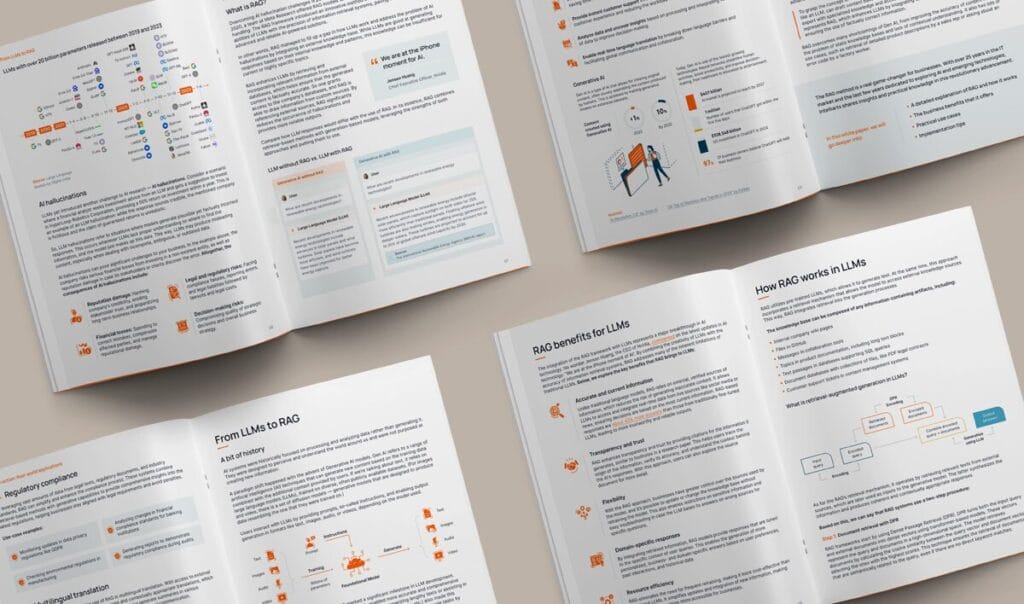
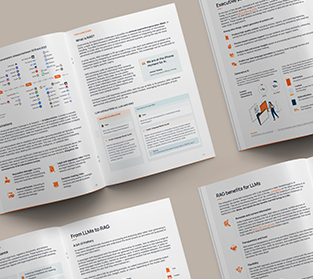
3 best practices for implementing Generative AI in marketing
Surely, the nuances of adopting AI are vast. However, let’s focus on three Generative AI use cases for marketing, which, if left overlooked, may make it impossible to use customized marketing solutions reinforced with AI.
#1 Map AI capabilities to specific goals
Essentially, you need to align generative AI for marketing with clearly defined objectives to maximize its potential. For example, Gen AI can offer capabilities for targeted audience segmentation, personalized content creation, or campaign analytics. Mapping listed and other capabilities, when keeping in mind limitations, ensures that strategies are well-thought-out. This drives better resource allocation and enables businesses to drive impactful generative marketing and advertising campaigns while achieving desired outcomes efficiently.
Microsoft provides learning materials to educate all enthusiasts on creating AI/ML Capabilities Map intended to tailor AI solutions to business goals. Don’t hesitate to utilize such guidelines when crafting your Gen AI for marketing strategy.
#2 Ensure that your data management is optimal
The success of generative AI in marketing hinges on the quality and management of input data. That’s why it’s essential to mind the data you feed your Generative AI for marketing. Having a solid big data collection process and clean, well-structured datasets ensure that AI models produce precise, contextually relevant outputs, while compromised quality of data may lead to critical errors in customer communications and marketing campaigns. Also, for content-driven SEO strategies, combining clean datasets with techniques like Python for NLP SEO can help extract semantic insights from large volumes of text, enabling smarter keyword targeting and better search visibility.
You may explore Garbage-In-Garbage-Out (GIGO) data management in ML rule and best data preparation practices in another blog post by Intelliarts.
#3 Establish the continuous learning and optimization flow
AI models used in generative AI and marketing must undergo regular updates, retraining, and testing to remain effective. These Generative AI marketing strategies reduces the adverse effects of feeding an AI model that applies continuous learning with real-life data since it may result in bias cumulated over time. It ensures that AI stays relevant, aligns with changing customer behaviors, addresses emerging trends, and
Challenges and risks of using Generative AI for marketing
The World Intellectual Property Organization (WIPO) expresses concerns regarding the usage of AI in business. They mention issues of bias, transparency, accountability, and privacy. In that regard, let’s explore business risks that, if left unhinged, may lead exactly to concerns coming true:
- Technical challenges: Developing and integrating generative market AI solutions can be complex, requiring high-quality data and seamless system integration. That’s why poor implementation may lead to inaccurate outputs, inefficiencies, or costly delays in marketing workflows.
- Ethical and legal risks: Generative AI models can inadvertently perpetuate biases, raising ethical concerns. Additionally, managing data privacy and ensuring compliance with GDPR provisions on AI and recommendations like European ethics guidelines for trustworthy AI is essential to avoid legal repercussions.
You may be interested in exploring Intelliarts’ blog post on the ethics of data collection for additional insight into the corresponding risks.
- Over-reliance on AI: Relying too heavily on AI without human oversight can lead to unchecked errors or inappropriate content generation. Balancing automation with human review ensures quality and context alignment.
- Cost and scalability issues: Implementing AI solutions can be resource-intensive, with high upfront costs and ongoing maintenance. Smaller businesses may struggle to scale AI effectively within budget constraints, limiting accessibility.
Each company is expected to figure out its own way of addressing challenges and risks associated with utilizing Gen AI on multiple levels across departments, including marketing. A basic framework for identifying and addressing risks is provided in the infographic below:
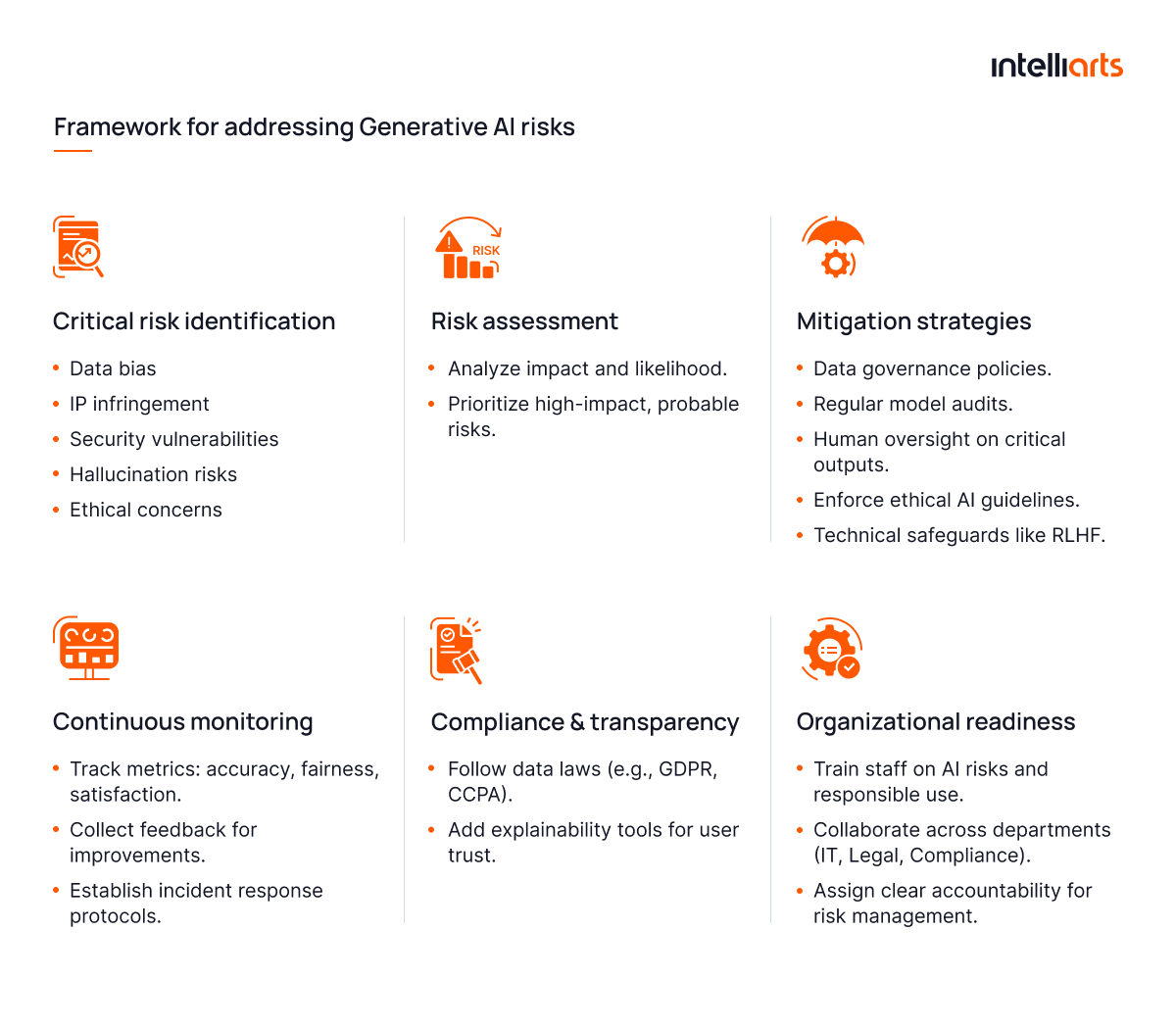
Should you need assistance with identifying Generative AI risks and creating ethical solutions, don’t hesitate to apply for technology consulting and AI development services by Intelliarts.
Future trends in Generative AI and marketing
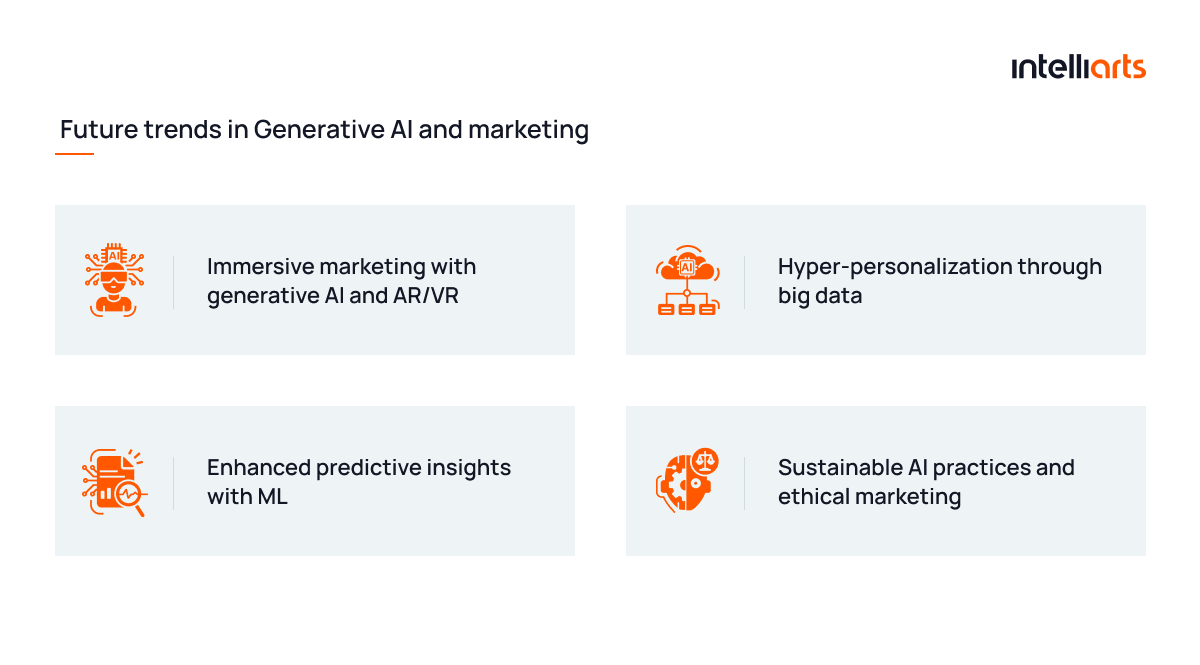
It’s safe to claim that the IT industry is fast-paced. The technologies that were introduced as early concepts only recently are gaining traction in the present. So, let’s find out what Generative AI advanced applications and modifications the marketing team may face in a few years:
- Immersive marketing with generative AI and AR/VR. The fusion of generative AI with AR/VR allows brands to craft experiences that feel real and interactive. Imagine virtual stores where AI generates tailored product recommendations based on your browsing history, or immersive storytelling campaigns where AR environments are dynamically created in real time.
- Hyper-personalization through big data. By leveraging big data insights, generative AI can analyze consumer behavior at an unprecedented depth, generating targeted ads, emails, and content that resonate with individual preferences. This goes beyond demographic segmentation into true personalization, boosting both engagement and ROI.
- Enhanced predictive insights with ML. When paired with machine learning in business, generative AI improves predictive modeling for marketing campaigns. It can foresee trends, customer needs, and market shifts, enabling businesses to stay ahead of the competition with data-driven strategies.
- Sustainable AI practices and ethical marketing. As generative AI gains traction, the emphasis on sustainability and ethical use is becoming critical. Sustainable AI practices, such as reducing the carbon footprint of large language models, are also a growing concern in the industry.
Emerging trends highlight how AI tools for business growth will transform marketing strategies. Besides, we should expect further increase in both the adoption of AI in marketing and the usefulness of this advanced technology on multiple levels.
For additional insights into practical implementations of the latest AI innovations, explore our AI assistant case study and AI-powered equipment consulting case study by Intelliarts.
Final take
Generative AI is revolutionizing marketing with its ability to personalize campaigns, optimize advertisements, and streamline content creation. By integrating AI thoughtfully and upon addressing challenges like data management and ethical concerns, businesses can harness its full potential in marketing for better engagement and ROI.
Here at Intelliarts, we specialize in creating tailored AI solutions for diverse business needs, from AI chatbots to AI car damage detection. We have worked, among our many other clients, with such famous brands as HubSpot, Nowsite, and Verity.
FAQ
1. What are the main benefits of generative AI for digital marketing?
Generative AI for marketing offers personalized content creation, faster campaign execution, and enhanced customer targeting. By automating repetitive tasks, generative AI in advertising and marketing boosts efficiency, allowing teams to focus on strategy. These tools also improve audience engagement by tailoring messages to individual preferences.
2. How do I know if my business is ready to implement Generative AI?
Your business is ready for generative AI tools for marketing if you have sufficient data, clear goals, and a strategy to integrate it with existing workflows. Consider whether use cases of generative AI for marketing, such as personalized ads or content generation, align with your objectives.
3. How can Generative AI improve my marketing ROI?
Generative AI in sales and marketing optimizes ad expenses through precise targeting and automates content creation to reduce costs. By delivering personalized experiences, generative AI fits into a marketing strategy by increasing engagement and conversions, ultimately driving a higher return on investment (ROI).
